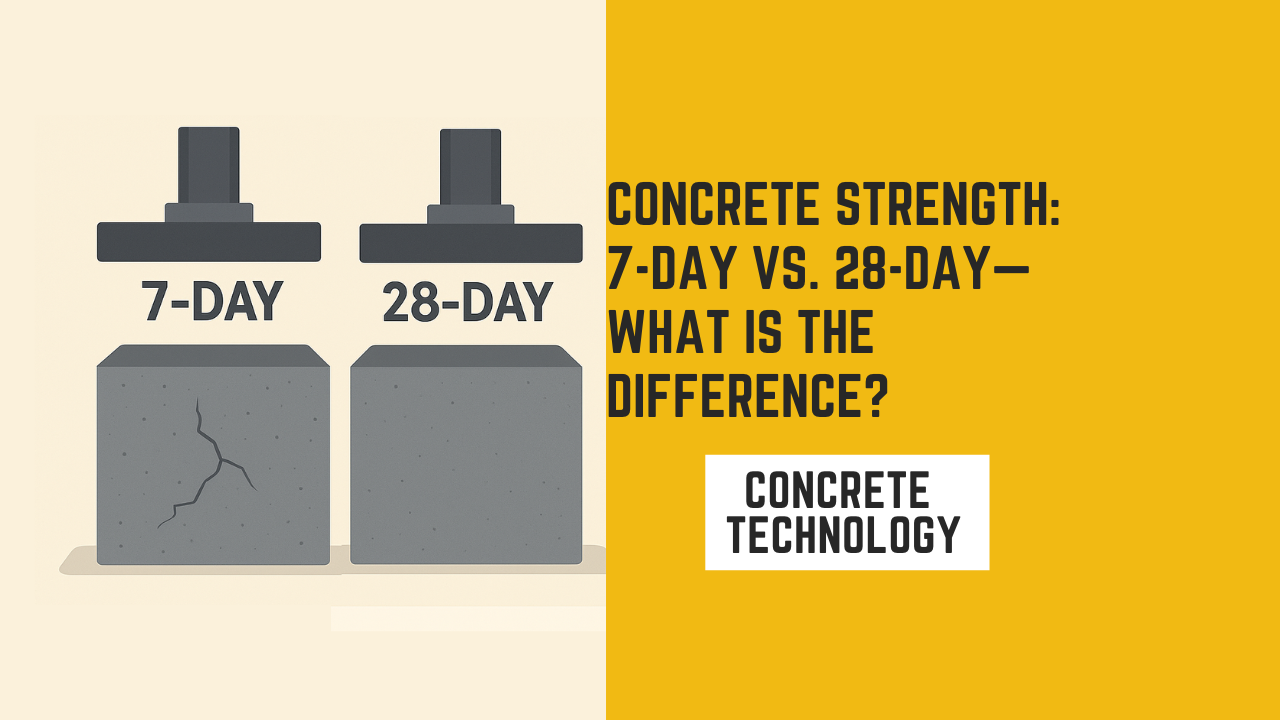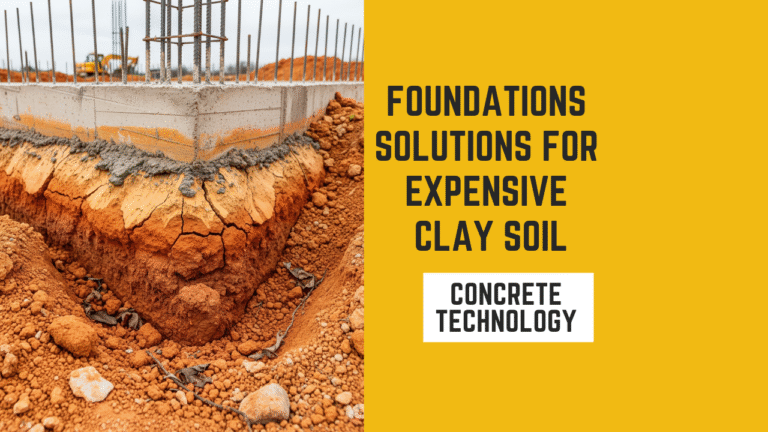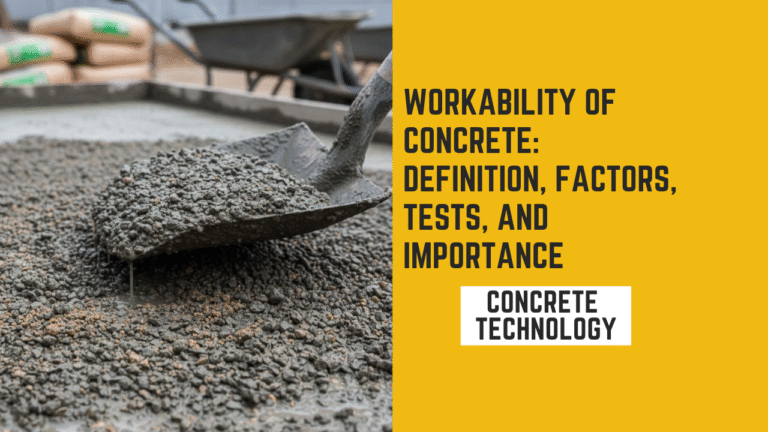Concrete Strength: 7-Day vs. 28-Day—What Is the Difference? Ultimate Guide

Concrete is the backbone of modern construction. From skyscrapers to bridges and dams to highways, every project relies heavily on the strength and durability of concrete. But did you know that the compressive strength of concrete is not tested only once but at different ages, most notably at 7 days and 28 days?
These two benchmarks are critical in the construction industry because they help engineers, contractors, and quality control experts assess whether the concrete will perform as expected in the long run. Understanding the difference between 7-day and 28-day concrete strength is crucial for structural safety, cost efficiency, and timely project delivery.
In this article we’ll take a deep dive into:
- What concrete strength means
- Why compressive strength is tested at 7-day and 28-day
- The relationship between early strength and final strength
- Industry standards and codes of practice
- Factors Influencing the strength development of concrete
- Case Studies and practical implications on-site
- Key Takeaways for engineers and contractors
What is Concrete Strength?
When we talk about “concrete strength,” we are usually referring to its compressive strength—the maximum stress concrete can withstand without failure when subjected to crushing forces
Compressive strength is measured by casting concrete specimens (commonly 150 mm x 150 mm cubes or 150 mm x 300 mm cylinders). Curing them under controlled conditions and testing them under a compression testing machine at a specific age. The result, expressed in megapascals (MPa) or pounds per square inch (psi), defines whether the concrete meets the specified grade (e.g., M20, M25, or C30/37)
Why 7-day and 28-day?
Concrete does not achieve its full strength immediately after placement. Instead, it gains strength gradually due to the hydration process, where cement reacts with water to form calcium-silicate-hydrate (C-S-H) gel that gives concrete its hardness
7-day strength
- Represents early-age strength
- Indicates how well the concrete is hydrating and setting
- Provide engineers with confidence that the mix will continue to develop strength.
28-day strength
- Considered the standard benchmark for concrete strength
- Almost all design codes (such as ACI, IS, and Eurocode) specify the characteristic compressive strength at 28 days
- Serves as the final quality check for compliance with specifications
Typical Relationship Between 7-Day and 28-Day Strength
A common rule of thumb in concrete technology is that
- Concrete at 7 days reaches approximately 60–70% of its 28-day strength
- By the 28th day, the concrete achieves its characteristic strength (100%)
For example,
| Concrete Grade | 28-Day Strength (MPa) | Expected 7-Day Strength (MPa) |
|---|---|---|
| M20 | 20 | 12 – 14 |
| M25 | 25 | 15 – 18 |
| M30 | 30 | 18 – 21 |
This relationship helps site engineers take decisions such as formwork removal, post-tensioning of tendons, or loading of structures before 28 days have passed
Industry Standards and Codes
Different international standards highlight the importance of testing concrete strength at specific ages:
- American Concrete Institute (ACI 318)—Defines compressive strength based on 28-day testing.
- Indian Standard IS 456:2000—Uses 28-day strength as the reference but recognizes 7-day testing for quality control.
- European Standard EN 206—Also specifies characteristic compressive strength at 28 days.
These codes accept that 7-day tests are not definitive, but they act as an early indicator. If the 7-day strength is much lower than expected, it raises red flags about mix design, workmanship, or curing.
Factors Affecting Strength Development
Several factors influence how quickly concrete gains strength at 7 days versus 28 days.
1. Cement Type
- Ordinary Portland cement (OPC) generally develops strength faster than blended cements (like PPC or slag cement)
- Rapid hardening cement can achieve over 70% of its strength within 7 days
2. Water-Cement Ratio (w/c ratio)
- A lower w/c ratio accelerates strength gain, while a higher ratio slows it down.
3. Curing conditions
- Proper curing (maintaining adequate moisture and temperature) ensures continued hydration.
- Poor curing can significantly reduce 28-day strength
4. Mix design
- Richer mixes (higher cement content) gain strength faster.
- Supplementary cementitious materials (fly ash, silica fume, GGBS) may slow early strength gain but enhance long-term strength
5. Temperature
- Warn conditions speed up hydration, while cold conditions delay it
Practical Importance of 7-Day vs 28-Day Strength
1. Early Quality Control
By checking 7-day strength, site engineers can detect potential problems with mix proportioning, curing, or materials. If strength is far below expected, corrective action can be taken before the structure is compromised.
2. Construction Scheduling
In fast-paced projects, contractors often rely on 7-day results to decide:
- When to remove formwork.
- When to allow light loads or construction activities.
- When to proceed with post-tensioning in prestressed concrete.
3. Structural Safety
28-day strength confirms whether the concrete meets the design requirements. Any deficiency at this stage may lead to costly remedial measures such as jacketing, chemical treatment, or even demolition in extreme cases.
Case Study – delayed strength gain
Consider a project using PPC (Portland Pozzolana Cement). After 7 days, the strength was only 55% of the target value, raising concrete. However, by 28 days, the concrete had exceeded its design strength due to the long-term pozzolanic reaction.
This highlights that 7-day tests alone cannot predict final performance, especially when blended cements are used.
Common Misconceptions
1. “7-day strength guarantees 28-day strength” Not always true. Poor curing or unfavorable conditions after 7 days can prevent concrete from reaching its target strength.
2. “Concrete stops gaining strength after 28 days”—Incorrect. Concrete continues to gain strength beyond 28 days, albeit at a slower rate. Research shows that strength can increase up to 90 days, 180 days, or even longer.
3. “All concretes follow the same 7-day/28-day ratio”—False. The ratio depends heavily on cement type, admixtures, and curing conditions.
Long-term strength development
While 28 days is the industry standard, some projects (like dams or mass concrete works) monitor concrete strength at 56 days, 90 days, or even 1 year. Blended cements and SCMs contribute to gradual strength gain, which makes long-term monitoring essential —
Summary of Differences—7-Day vs 28-Day Strength
| Aspect | 7-Day Strength | 28-Day Strength |
|---|---|---|
| Purpose | Early-age quality check | Standard benchmark for design |
| Typical Value | 60–70% of 28-day strength | 100% (characteristic strength) |
| Usage | Formwork removal, scheduling | Final compliance check |
| Reliability | Indicative only, not final | Conclusive and binding |
Key Takeaways
- 7-day strength gives a preview of how concrete is developing
- 28-day strength is the industry standard used for design and acceptance
- A well-designed mix should reach about 60-70% strength in 7 days.
- Factors like cement type, curing, and temperature significantly affect strength development.
- Engineers should use both 7-day and 28-day results together to ensure quality and safety
Conclusion
The difference between 7-day and 28-day concrete strength is more than just numbers on a test report—it represents the balance between early quality control and long-term performance assurance. While 7-day results give confidence that the mix is on track, 28-day strength is the ultimate measure of compliance with design specifications
By understanding this distinction, engineers and contractors can make informed decisions, avoid costly delays, and ensure that structures achieve the strength and durability expected of them






